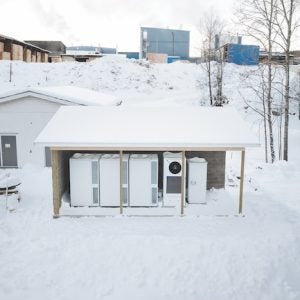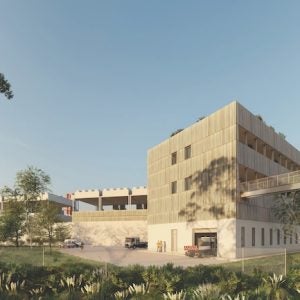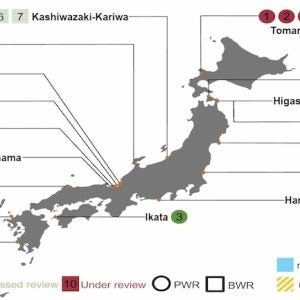Just 40 km outside the city of Samcheok, in Gangwon-do province on the east coast of South Korea, state-owned power company Korea Southern Power Company (KOSPO) is hard at work on a revolutionary power generation project aimed at providing economic, green energy to the country. The Samcheok Green Power Project, which is being built on a 2.6 million m2 site of reclaimed coastal land, will not only generate electricity from various renewable energy sources but will also be the country’s first use of advanced ultrasupercritical circulating fluidised bed technology.
The plant is being equipped with four CFB boilers in tandem with two steam turbine generators, for a total net generating capacity of 2000 MW. An additional 1000 MW will come from a combination of fossil-fired and renewable generation. There are also plans to generate electricity from a fuel cell plant at a nearby facility owned by Korea Gas Corporation.
Why CFB?
The South Korean story is one of strong economic growth, which in turn is driving power demand. Like Japan, Korea has no significant indigenous energy resources and is heavily dependent on fuel imports. It is also in a region where oil and gas prices have been among the highest in the world. Meanwhile, plans for new nuclear plants have slowed in the aftermath of Fukushima and, with their long lead-times, they are not an option for meeting urgent demand.
After a comprehensive study of boiler technologies KOSPO decided that CFB boilers could reliably fire low quality coals and save millions of dollars in fuel cost over the life of the plant as compared to conventional pulverised coal boilers firing higher quality, more expensive, coal (see graphs below).
This decision resulted in a contract being awarded to Amec Foster Wheeler in 2011 for the design and supply of four 550 MWe (gross) ultrasupercritical boilers for the first phase of the project, making it the largest CFB plant in the world. This first phase (Units 1 and 2) will be configured as two blocks with each block having two boilers feeding into an 1100 MW (gross) steam turbine.
Coal remains the most economic fuel for large scale power production to meet South Korea’s energy demand. CFB technology has the flexibility to burn the lower quality coals which trade at a substantial price discount to premium steam coals. The Samcheok plant will fire imported and domestic coals with heating values in the range 4000-5000 kcal/kg.
Another source of cost savings relates to the fact that the plant doesn’t need traditional flue gas desulphurisation (FGD) systems since the CFB boilers capture the fuel’s sulphur as it burns. This absence of FGD is perhaps surprising considering that the Samcheok plant will be among the cleanest coal burning power plants in the world, and will set a new standard for green power in Korea.
NOx and SOx emissions are each guaranteed at 50 ppm (@6%O2). Dust emissions will be controlled by electrostatic precipitators so that particulates do not exceed 20 mg/Nm3. Carbon dioxide emissions are estimated at around 800 g/ kWh, which is about 25 per cent below a typical operating coal plant in Korea today.
The plants green credentials are further enhanced by the use of biomass. The plant is expected to burn 5% biomass in terms of heat input, depending on availability. Korea has extensive forests and there are options for sourcing recycled wood waste from the local lumber industry or importing wood pellets from overseas markets.
The biomass will be delivered by barge to a dedicated off-load dock located at the side of the plant. Little to no preparation of the biomass is needed before it is burned in the CFB boilers, due to the CFB’s flexible combustion process. The biomass doesn’t require drying and needs only chipping to about 5 cm top size before being pneumatically transported, stored in silos and fed to the CFBs.
Coal will be delivered to an unloading dock located at the front of the plant. The dock uses a bilateral mooring scheme, where two coal barges can dock on both sides of the pier in order to maximise usable space, while reducing construction costs of the seawall.
Remarkably, there will be no visible coal at the site. Coal will be stored in enclosed coal bunkers, with photovoltaic panels on the roofs. Coal will be conveyed underground to the boilers, so there will be no coal dust blown into the surroundings, as is typical at plants where coal is stored in open piles above ground.
Once-through ultrasupercritical
The Amec Foster Wheeler once-through ultrasupercritical CFB boilers for Samcheok employ advanced vertical-tube low-mass- flux Benson evaporator technology, which achieves higher efficiency and is easier to build and maintain than conventional spiral- wound supercritical boiler systems.
The Samcheok boilers achieve a steam temperature of 603°C (main and reheat), resulting in an estimated net plant electrical efficiency of 42.4% (LHV).
The vertical tube boiler design was selected due to the several advantages it offers over conventional spiral tube designs. For example, there is a lower steam pressure drop across the boiler, reducing boiler feedwater pump power, further improving plant efficiency. Also, since the tubes are vertical, the design avoids the complicated support system needed for spiral tube boilers, making the vertical tube boiler easier to construct and repair.
In addition, the low steam mass flows and velocities in the vertical tubes result in a self-cooling dynamic which naturally increases the steam flow to and cooling of tubes receiving higher heat, limiting temperature differences and stresses across the furnace walls.
Further, the design allows the use of many of the same relatively low cost and low maintenance materials used in subcritical boilers, except in the final superheater section. With pulverised coal boilers, superheating takes place at the top of the boiler. In Amec Foster Wheeler’s CFB boilers, final superheating is done in a high efficiency fluidised bed heat exchanger, called an INTREX, which protects the high temperature superheating heating coils from the corrosive flue gases in the furnace. This means the same supercritical temperatures can be reached using a lower grade coil material than would be needed in a PC boiler and that a lower quality fuel can be used without sacrificing steam temperature or unit reliability.
The technology advance to once-through ultrasupercritical CFB units was first demonstrated at the 460 MWe Lagisza plant in Poland, which entered commercial operation in 2009. Since its startup, the plant has operated on a range of bituminous coals and has demonstrated a net plant electrical efficiency of 43.3% (LHV). Another supercritical CFB project is also underway in Russia. This is a 330 MWe CFB unit designated Novocherkasskaya GRES No 9.
The CFB boiler, which is the first of its kind in the country, is capable of combusting a wide selection of fuels including anthracite, bituminous coal and coal slurry.
The Samcheok Green Power Plant is the next big step for advancing large scale economic power generation utilising CFB technology. The plant in Poland was the first step into the utility sector. The Samcheok Green Power Project will certainly do a great deal to help Korea demonstrate its green credentials as it is globally recognised as a model power plant.
Renewables showcase
In addition to using the biggest and most advanced ultrasupercritical CFB boilers, the Samcheok Green Power Project will be a showcase for renewable technologies.
KOSPO aims to use a range of renewable energy sources at the plant, and plans to install: wind turbines on the seawall; solar photovoltaic panels on the roofs of buildings and slopes of the site; a small hydropower generator at the drainage canal; and wave
power generation units at the seawall. A fuel cell facility will use gas from Korea Gas Corporation and bog gas to generate power.
A centre is to be set up within the power plant to research and develop technologies aimed at reducing CO2 emissions. For example, some of the gas from the stack will be diverted to the research centre to investigate the CO2 absorption capabilities of algae and other plant life. KOSPO also plans to conduct research into gasification through a gasification facility that will gasify some of the coal to produce syngas.
Samcheok Green Power Project will also showcase what is possible in terms of complete energy efficiency and sustainability. The coal units’ stacks are integrated with the power plant office buildings and control room in an architectural design that will see excess heat from the power plant chimneys used to heat the office buildings and other buildings on the site. The plant will feature an energy saving electricity system, with an intelligent lighting control system using natural and LED lighting.
There is also a focus on water conservation and recycling. According to KOSPO, specific emphasis was placed on water supply and disposal methods. Water for the power plant will be secured in several ways, including: bank filtration; rainfall purification; and seawater desalination. The plant will also recycle all outflows by establishing an integrated water and wastewater treatment system that will minimise the plant’s water usage. Environment friendly bio-paints will be applied to pipes buried under the ground and sea to prevent corrosion.
First fire
Following the award of the contract for Samcheok in May 2011, Amec Foster Wheeler was given the notice to proceed (NTP) in July 2011. The plant is close to completion, with first fire achieved on unit 1B and 1A in February/March of 2016 and Unit 1’s 1100 MW turbine synchronisation scheduled for May 2016. Unit 2 commissioning will follow within a few months.






